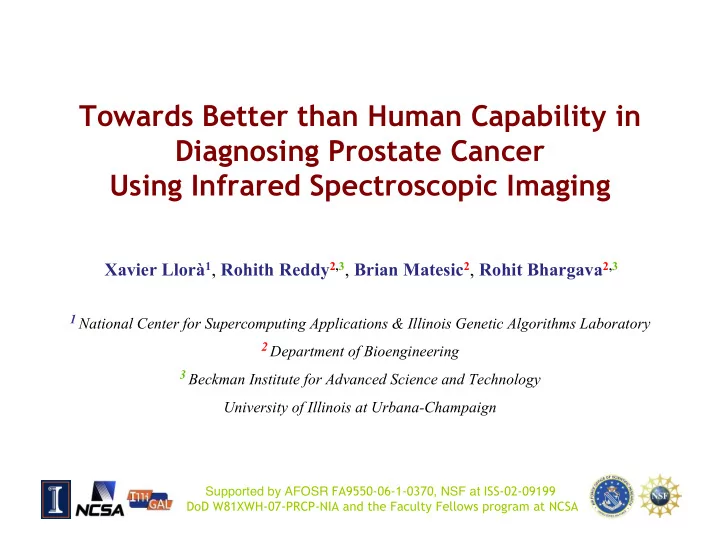

Towards Better than Human Capability in Diagnosing Prostate Cancer Using Infrared Spectroscopic Imaging Xavier Llorà 1 , Rohith Reddy 2,3 , Brian Matesic 2 , Rohit Bhargava 2,3 1 National Center for Supercomputing Applications & Illinois Genetic Algorithms Laboratory 2 Department of Bioengineering 3 Beckman Institute for Advanced Science and Technology University of Illinois at Urbana-Champaign Supported by AFOSR FA9550-06-1-0370 , NSF at ISS-02-09199 DoD W81XWH-07-PRCP-NIA and the Faculty Fellows program at NCSA GECCO 2007 HUMIES 1
Prostate Cancer Diagnosis using FTIR • Pathologist diagnose cancer from structures in stained tissue. • Fourier transform infrared spectroscopy imaging. – Combines chemistry and structure • The sweep of the tissue provides a 3D spectral image. • The spectra contain a chemical signature of the cell/pixel. • Two step process: – Tissue identification (key tissue: epithelial/stroma) – Diagnose anomalous tissues (benign/malignant/degree) GECCO 2007 HUMIES Llorà, Reddy, Matesic & Bhargava 2
Why Does This Matter? • One in six men will be diagnosed with prostate cancer (US) during their lifetime. • Pathologist opinion of structures in stained tissue is the definitive diagnosis for almost all cancers – Also critical for therapy, drug development, epidemiology, public policy. • Biopsy-staining-microscopy-manual recognition approach has been used for over 150 years. • No automated method has far proven to be human competitive. • The lack of automation leads to – heavy workloads for pathologists, increased costs and errors. • The method can be generalized to biopsies of any type of cancer (current studies include prostate, colon, and breast) GECCO 2007 HUMIES Llorà, Reddy, Matesic & Bhargava 3
GBML Identifies Tissue Types Accurately • Large volume of Original OK labeled arrays • Spectra transformed (features, tissue type) • Incremental rule learning based on set covering: Misclassified – Reduce the memory footprint required – Efficient and scalable implementation (hardware and software parallelization) • Accuracy >96% • Mistakes on minority classes (not targeted) and boundaries GECCO 2007 HUMIES Llorà, Reddy, Matesic & Bhargava 4
Filtered Tissue is Accurately Diagnosed Original • Epithelial and stroma used for diagnosis • Spectra transformed (features, diagnosis) • GBML to reproduce human diagnosis • Pixel crossvalidation accuracy (87.34%) • Spot accuracy – 68 of 69 malignant spots Diagnosed – 70 of 71 benign spots • Human-competitive computer-aided diagnosis system is possible • First published results that fall in the range of human error (<5%) GECCO 2007 HUMIES Llorà, Reddy, Matesic & Bhargava 5
Human Competitive Claims: Criteria B,D,E • Criterion B: The result is equal to or better than a result that was accepted as a new scientific result at the time when it was published in a peer-reviewed scientific journal. • Criterion D: The result is publishable in its own right as a new scientific result 3/4 independent of the fact that the result was mechanically created. • Criterion E: The result is equal to or better than the most recent human-created solution to a long-standing problem for which there has been a succession of increasingly better human- created solutions. GECCO 2007 HUMIES Llorà, Reddy, Matesic & Bhargava 6
Criterion B: Better Than Result Accepted As A New Scientific Result • Current best published result, examples from different fields – Image Analysis - 77% accuracy 1 (cancer/no cancer) – Raman Spectroscopy – 86% 2 accuracy – Genomic analysis – 76% (low grade/high grade cancer) • FTIR – 2 out of 140 samples detected wrong (this study) • GBML results – First automated method to replicate human accuracy in diagnosis – General approach applicable to different types of tissue/cancer – Advances on GBML mine large scale data sets 1. R. Stotzka et al. Anal. Quant. Cytol. Histol.,17, 204-218 (1995). 2. P. Crow et al. Urol. 65, 1126-1130 (2005) 3. L. True et al. Proc Natl Acad Sci U S A. 2006 Jul 18;103(29):10991-10996. GECCO 2007 HUMIES Llorà, Reddy, Matesic & Bhargava 7
Criterion D: GBML Results are Publishable • Paper in GECCO in the Real World Applications track • Journal article in press: – Jounal of Natural Computing. Special issue on Learning Classifier Systems (Ed. Larry Bull) • Preparing a unifying book chapter describing the complete process: – Learning Classifier Systems in Data Mining (Ed. Larry Bull and Ester Bernadó) • Preparing a journal article for a top medical journal on the results and implication for clinical diagnosis: – Nature Medicine GECCO 2007 HUMIES Llorà, Reddy, Matesic & Bhargava 8
Criterion E: The result is equal to or better than the most recent human-created solution • Previous models were unable to match pathologist accuracy • Patient diagnostic accuracy did not break the 75- 90% barrier • Our approach: – Accurately predict 87.43% of the raw pixels – Overall patient diagnosis accuracy >95%, which is in the region of human performance by the world's leading authorities in prostate cancer – Likely beats community and average pathologists • Lack of studies due to liability issues and follow up problems GECCO 2007 HUMIES Llorà, Reddy, Matesic & Bhargava 9
Why This is the “Best” Among Other HUMIES Submissions? • Social impact: Prostate cancer accounts for one-third of noncutaneous cancers diagnosed in US men and it is a leading cause of cancer-related death. • Interdisciplinary effort: Combine expertise in molecular chemistry, microscopy image processing for spectroscopy and structural information, optimization, and genetics-based machine learning. • Methodology transference: Our current initial experiments with other tissues—breast and colon—show very similar human-competitive results. • Breakthrough: First human-competitive results in 150 years. GECCO 2007 HUMIES Llorà, Reddy, Matesic & Bhargava 10
Recommend
More recommend